Contractual Negligence and Liability: Business Law Analysis and Cases
VerifiedAdded on 2020/10/05
|14
|4780
|362
Report
AI Summary
This report provides a comprehensive analysis of contract negligence within a business context. It begins with an introduction to the essential elements of a valid contract, including offer, acceptance, and consideration, and explores the impact of various contract types such as bilateral, unilateral, express, implied, and quasi contracts. The report then analyzes the different terms in a contract, differentiating between conditions, warranties, and exclusion clauses, with case examples to illustrate their application. The core of the report focuses on the elements of the tort of negligence, the nature of liability in negligence, and the concept of vicarious liability within a business setting. The report also examines the elements of the tort of negligence and available defenses in different business situations, including vicarious liability and its implications. The report includes elements of contract in a business scenario and elements of tort of negligence. The report concludes with a synthesis of the findings and highlights the significance of understanding contract and negligence principles for businesses to mitigate risks and ensure legal compliance. The report draws on case examples to illustrate key concepts, such as Re McArdle and Thornton v Shoe Lane Parking.
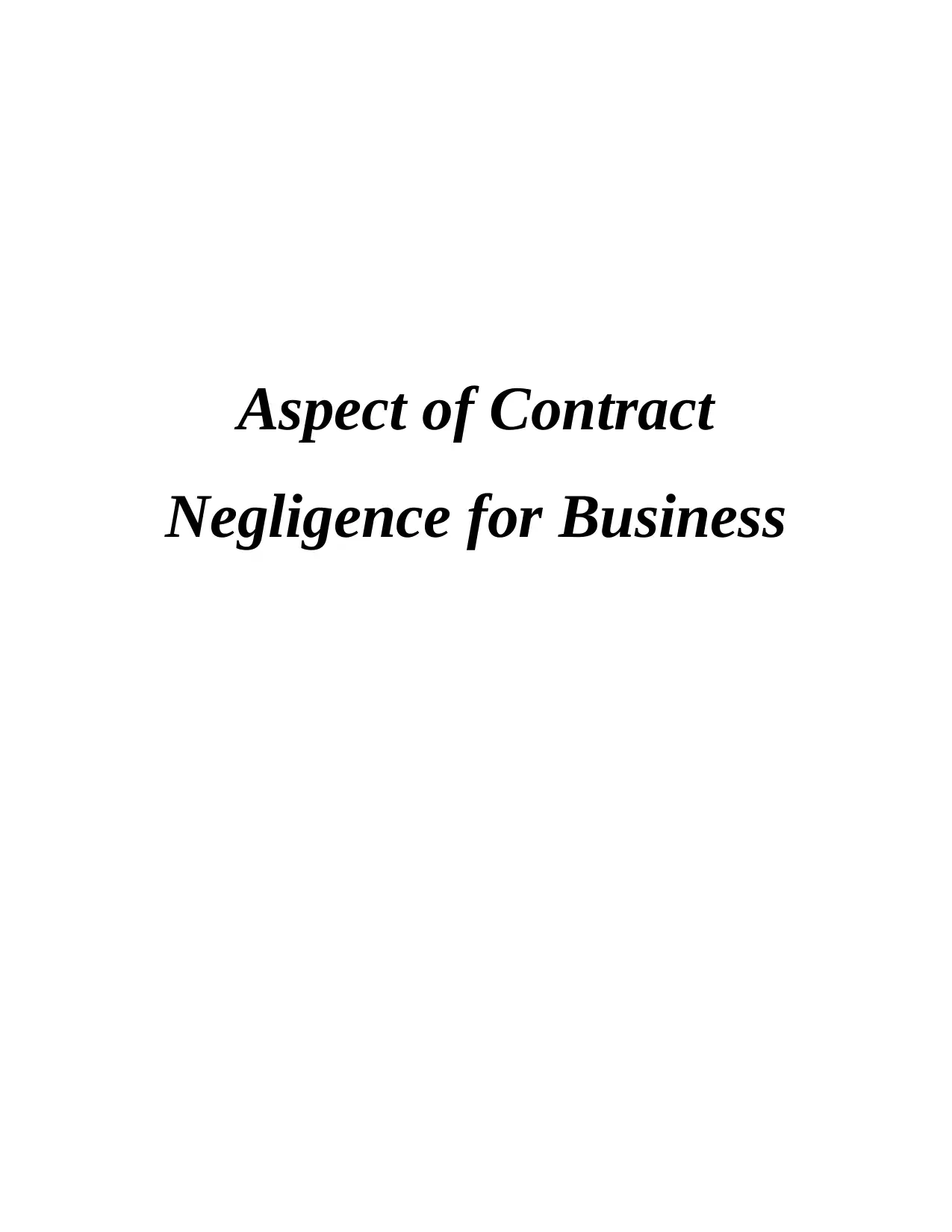
Aspect of Contract
Negligence for Business
Negligence for Business
Paraphrase This Document
Need a fresh take? Get an instant paraphrase of this document with our AI Paraphraser
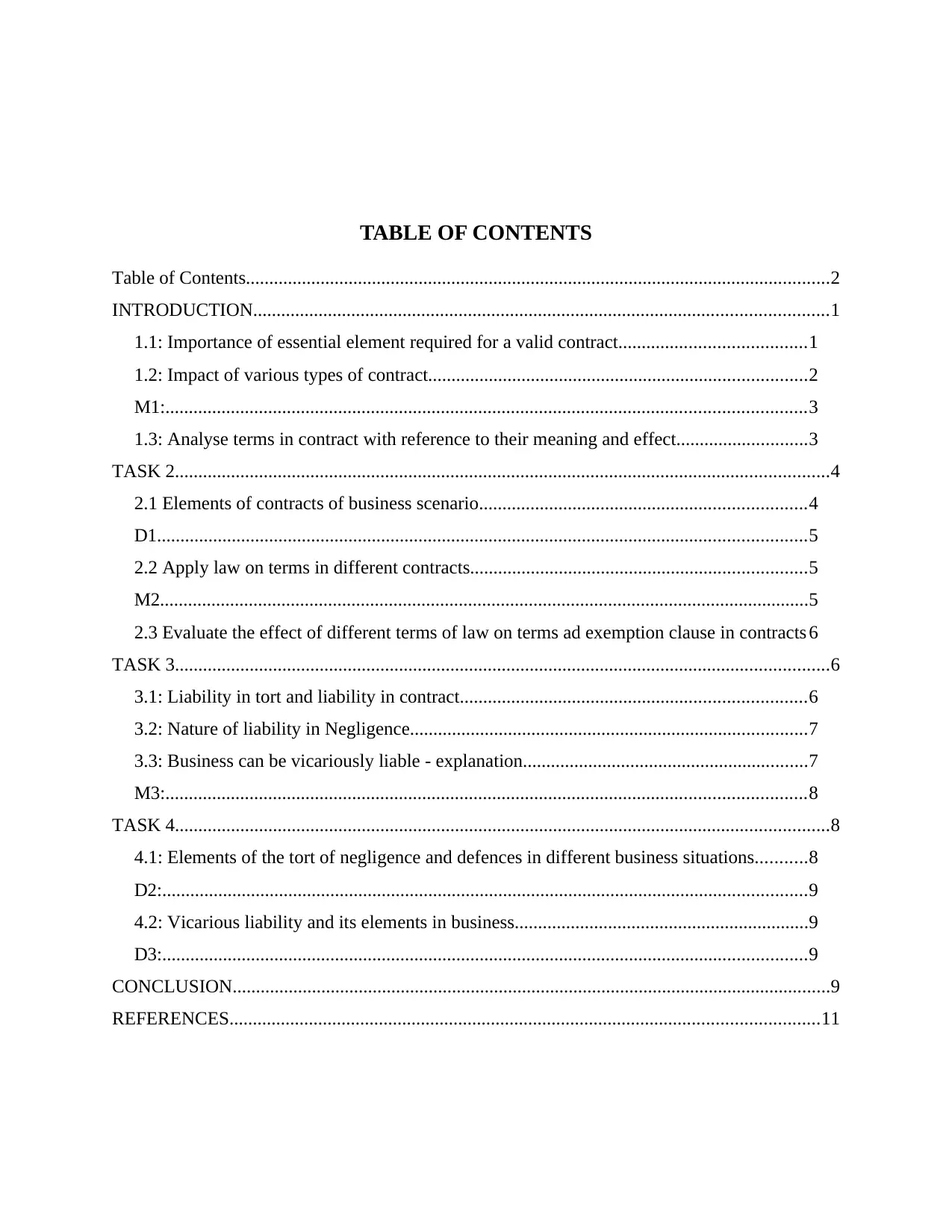
TABLE OF CONTENTS
Table of Contents.............................................................................................................................2
INTRODUCTION...........................................................................................................................1
1.1: Importance of essential element required for a valid contract........................................1
1.2: Impact of various types of contract.................................................................................2
M1:.........................................................................................................................................3
1.3: Analyse terms in contract with reference to their meaning and effect............................3
TASK 2............................................................................................................................................4
2.1 Elements of contracts of business scenario......................................................................4
D1...........................................................................................................................................5
2.2 Apply law on terms in different contracts........................................................................5
M2...........................................................................................................................................5
2.3 Evaluate the effect of different terms of law on terms ad exemption clause in contracts 6
TASK 3............................................................................................................................................6
3.1: Liability in tort and liability in contract..........................................................................6
3.2: Nature of liability in Negligence.....................................................................................7
3.3: Business can be vicariously liable - explanation.............................................................7
M3:.........................................................................................................................................8
TASK 4............................................................................................................................................8
4.1: Elements of the tort of negligence and defences in different business situations...........8
D2:..........................................................................................................................................9
4.2: Vicarious liability and its elements in business...............................................................9
D3:..........................................................................................................................................9
CONCLUSION................................................................................................................................9
REFERENCES..............................................................................................................................11
Table of Contents.............................................................................................................................2
INTRODUCTION...........................................................................................................................1
1.1: Importance of essential element required for a valid contract........................................1
1.2: Impact of various types of contract.................................................................................2
M1:.........................................................................................................................................3
1.3: Analyse terms in contract with reference to their meaning and effect............................3
TASK 2............................................................................................................................................4
2.1 Elements of contracts of business scenario......................................................................4
D1...........................................................................................................................................5
2.2 Apply law on terms in different contracts........................................................................5
M2...........................................................................................................................................5
2.3 Evaluate the effect of different terms of law on terms ad exemption clause in contracts 6
TASK 3............................................................................................................................................6
3.1: Liability in tort and liability in contract..........................................................................6
3.2: Nature of liability in Negligence.....................................................................................7
3.3: Business can be vicariously liable - explanation.............................................................7
M3:.........................................................................................................................................8
TASK 4............................................................................................................................................8
4.1: Elements of the tort of negligence and defences in different business situations...........8
D2:..........................................................................................................................................9
4.2: Vicarious liability and its elements in business...............................................................9
D3:..........................................................................................................................................9
CONCLUSION................................................................................................................................9
REFERENCES..............................................................................................................................11

⊘ This is a preview!⊘
Do you want full access?
Subscribe today to unlock all pages.

Trusted by 1+ million students worldwide
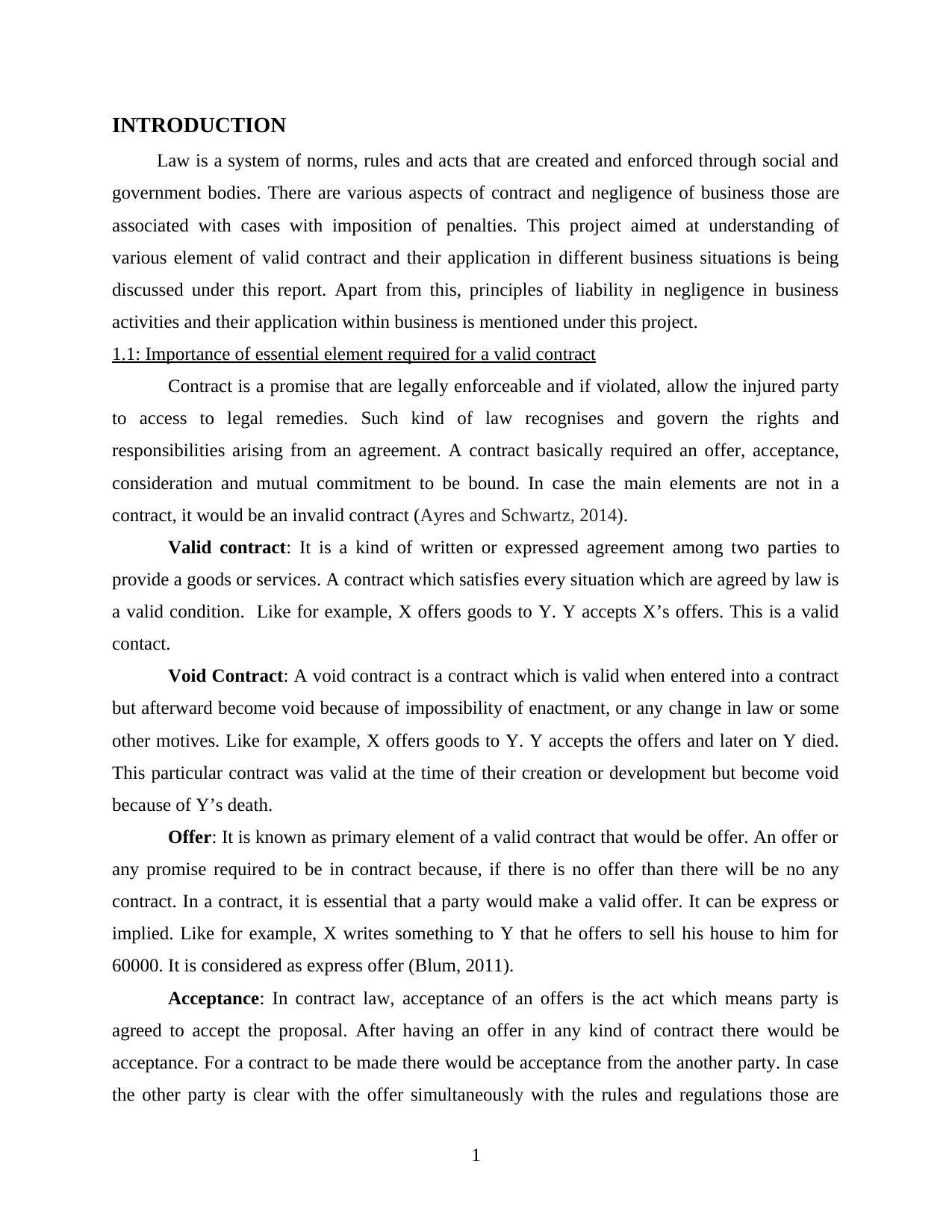
INTRODUCTION
Law is a system of norms, rules and acts that are created and enforced through social and
government bodies. There are various aspects of contract and negligence of business those are
associated with cases with imposition of penalties. This project aimed at understanding of
various element of valid contract and their application in different business situations is being
discussed under this report. Apart from this, principles of liability in negligence in business
activities and their application within business is mentioned under this project.
1.1: Importance of essential element required for a valid contract
Contract is a promise that are legally enforceable and if violated, allow the injured party
to access to legal remedies. Such kind of law recognises and govern the rights and
responsibilities arising from an agreement. A contract basically required an offer, acceptance,
consideration and mutual commitment to be bound. In case the main elements are not in a
contract, it would be an invalid contract (Ayres and Schwartz, 2014).
Valid contract: It is a kind of written or expressed agreement among two parties to
provide a goods or services. A contract which satisfies every situation which are agreed by law is
a valid condition. Like for example, X offers goods to Y. Y accepts X’s offers. This is a valid
contact.
Void Contract: A void contract is a contract which is valid when entered into a contract
but afterward become void because of impossibility of enactment, or any change in law or some
other motives. Like for example, X offers goods to Y. Y accepts the offers and later on Y died.
This particular contract was valid at the time of their creation or development but become void
because of Y’s death.
Offer: It is known as primary element of a valid contract that would be offer. An offer or
any promise required to be in contract because, if there is no offer than there will be no any
contract. In a contract, it is essential that a party would make a valid offer. It can be express or
implied. Like for example, X writes something to Y that he offers to sell his house to him for
60000. It is considered as express offer (Blum, 2011).
Acceptance: In contract law, acceptance of an offers is the act which means party is
agreed to accept the proposal. After having an offer in any kind of contract there would be
acceptance. For a contract to be made there would be acceptance from the another party. In case
the other party is clear with the offer simultaneously with the rules and regulations those are
1
Law is a system of norms, rules and acts that are created and enforced through social and
government bodies. There are various aspects of contract and negligence of business those are
associated with cases with imposition of penalties. This project aimed at understanding of
various element of valid contract and their application in different business situations is being
discussed under this report. Apart from this, principles of liability in negligence in business
activities and their application within business is mentioned under this project.
1.1: Importance of essential element required for a valid contract
Contract is a promise that are legally enforceable and if violated, allow the injured party
to access to legal remedies. Such kind of law recognises and govern the rights and
responsibilities arising from an agreement. A contract basically required an offer, acceptance,
consideration and mutual commitment to be bound. In case the main elements are not in a
contract, it would be an invalid contract (Ayres and Schwartz, 2014).
Valid contract: It is a kind of written or expressed agreement among two parties to
provide a goods or services. A contract which satisfies every situation which are agreed by law is
a valid condition. Like for example, X offers goods to Y. Y accepts X’s offers. This is a valid
contact.
Void Contract: A void contract is a contract which is valid when entered into a contract
but afterward become void because of impossibility of enactment, or any change in law or some
other motives. Like for example, X offers goods to Y. Y accepts the offers and later on Y died.
This particular contract was valid at the time of their creation or development but become void
because of Y’s death.
Offer: It is known as primary element of a valid contract that would be offer. An offer or
any promise required to be in contract because, if there is no offer than there will be no any
contract. In a contract, it is essential that a party would make a valid offer. It can be express or
implied. Like for example, X writes something to Y that he offers to sell his house to him for
60000. It is considered as express offer (Blum, 2011).
Acceptance: In contract law, acceptance of an offers is the act which means party is
agreed to accept the proposal. After having an offer in any kind of contract there would be
acceptance. For a contract to be made there would be acceptance from the another party. In case
the other party is clear with the offer simultaneously with the rules and regulations those are
1
Paraphrase This Document
Need a fresh take? Get an instant paraphrase of this document with our AI Paraphraser
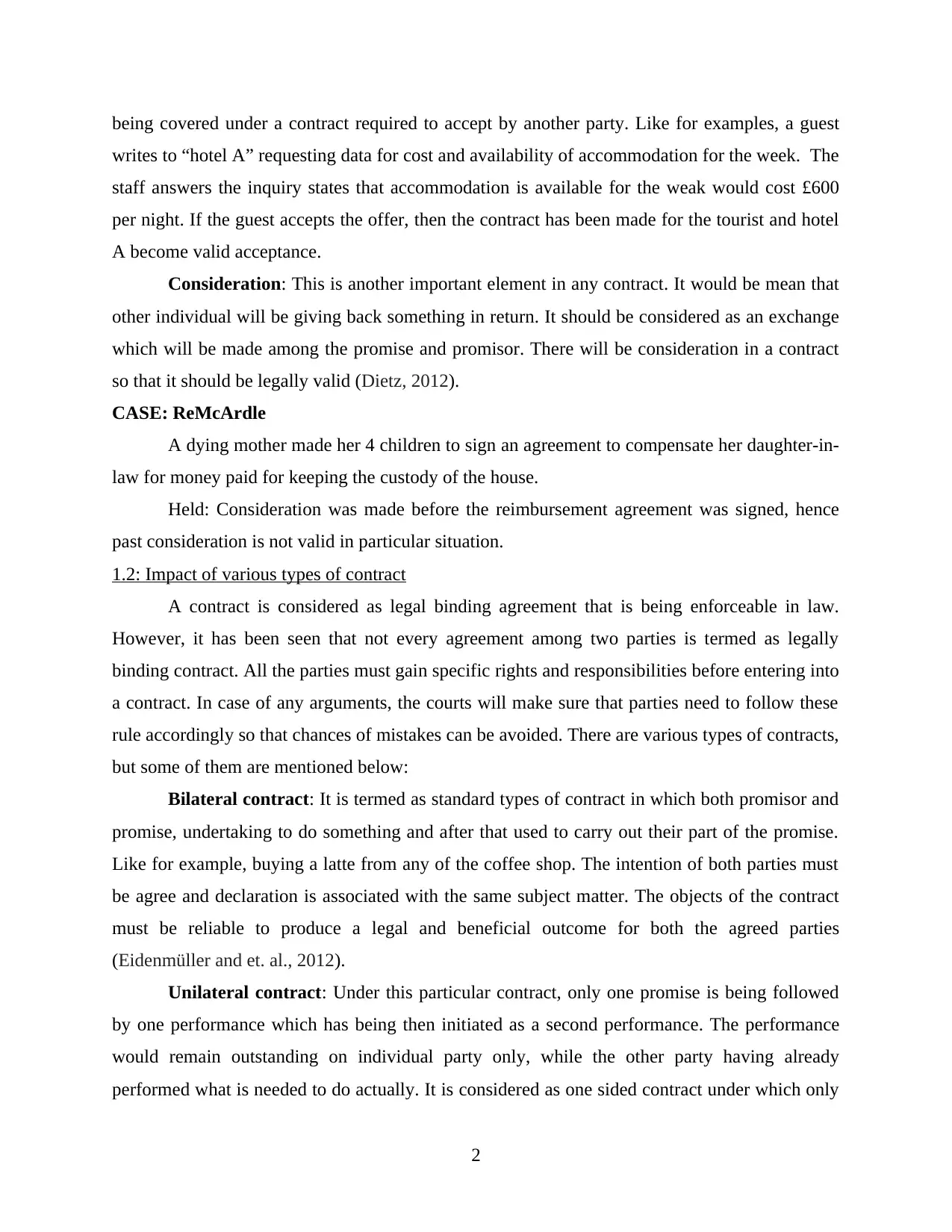
being covered under a contract required to accept by another party. Like for examples, a guest
writes to “hotel A” requesting data for cost and availability of accommodation for the week. The
staff answers the inquiry states that accommodation is available for the weak would cost £600
per night. If the guest accepts the offer, then the contract has been made for the tourist and hotel
A become valid acceptance.
Consideration: This is another important element in any contract. It would be mean that
other individual will be giving back something in return. It should be considered as an exchange
which will be made among the promise and promisor. There will be consideration in a contract
so that it should be legally valid (Dietz, 2012).
CASE: ReMcArdle
A dying mother made her 4 children to sign an agreement to compensate her daughter-in-
law for money paid for keeping the custody of the house.
Held: Consideration was made before the reimbursement agreement was signed, hence
past consideration is not valid in particular situation.
1.2: Impact of various types of contract
A contract is considered as legal binding agreement that is being enforceable in law.
However, it has been seen that not every agreement among two parties is termed as legally
binding contract. All the parties must gain specific rights and responsibilities before entering into
a contract. In case of any arguments, the courts will make sure that parties need to follow these
rule accordingly so that chances of mistakes can be avoided. There are various types of contracts,
but some of them are mentioned below:
Bilateral contract: It is termed as standard types of contract in which both promisor and
promise, undertaking to do something and after that used to carry out their part of the promise.
Like for example, buying a latte from any of the coffee shop. The intention of both parties must
be agree and declaration is associated with the same subject matter. The objects of the contract
must be reliable to produce a legal and beneficial outcome for both the agreed parties
(Eidenmüller and et. al., 2012).
Unilateral contract: Under this particular contract, only one promise is being followed
by one performance which has being then initiated as a second performance. The performance
would remain outstanding on individual party only, while the other party having already
performed what is needed to do actually. It is considered as one sided contract under which only
2
writes to “hotel A” requesting data for cost and availability of accommodation for the week. The
staff answers the inquiry states that accommodation is available for the weak would cost £600
per night. If the guest accepts the offer, then the contract has been made for the tourist and hotel
A become valid acceptance.
Consideration: This is another important element in any contract. It would be mean that
other individual will be giving back something in return. It should be considered as an exchange
which will be made among the promise and promisor. There will be consideration in a contract
so that it should be legally valid (Dietz, 2012).
CASE: ReMcArdle
A dying mother made her 4 children to sign an agreement to compensate her daughter-in-
law for money paid for keeping the custody of the house.
Held: Consideration was made before the reimbursement agreement was signed, hence
past consideration is not valid in particular situation.
1.2: Impact of various types of contract
A contract is considered as legal binding agreement that is being enforceable in law.
However, it has been seen that not every agreement among two parties is termed as legally
binding contract. All the parties must gain specific rights and responsibilities before entering into
a contract. In case of any arguments, the courts will make sure that parties need to follow these
rule accordingly so that chances of mistakes can be avoided. There are various types of contracts,
but some of them are mentioned below:
Bilateral contract: It is termed as standard types of contract in which both promisor and
promise, undertaking to do something and after that used to carry out their part of the promise.
Like for example, buying a latte from any of the coffee shop. The intention of both parties must
be agree and declaration is associated with the same subject matter. The objects of the contract
must be reliable to produce a legal and beneficial outcome for both the agreed parties
(Eidenmüller and et. al., 2012).
Unilateral contract: Under this particular contract, only one promise is being followed
by one performance which has being then initiated as a second performance. The performance
would remain outstanding on individual party only, while the other party having already
performed what is needed to do actually. It is considered as one sided contract under which only
2
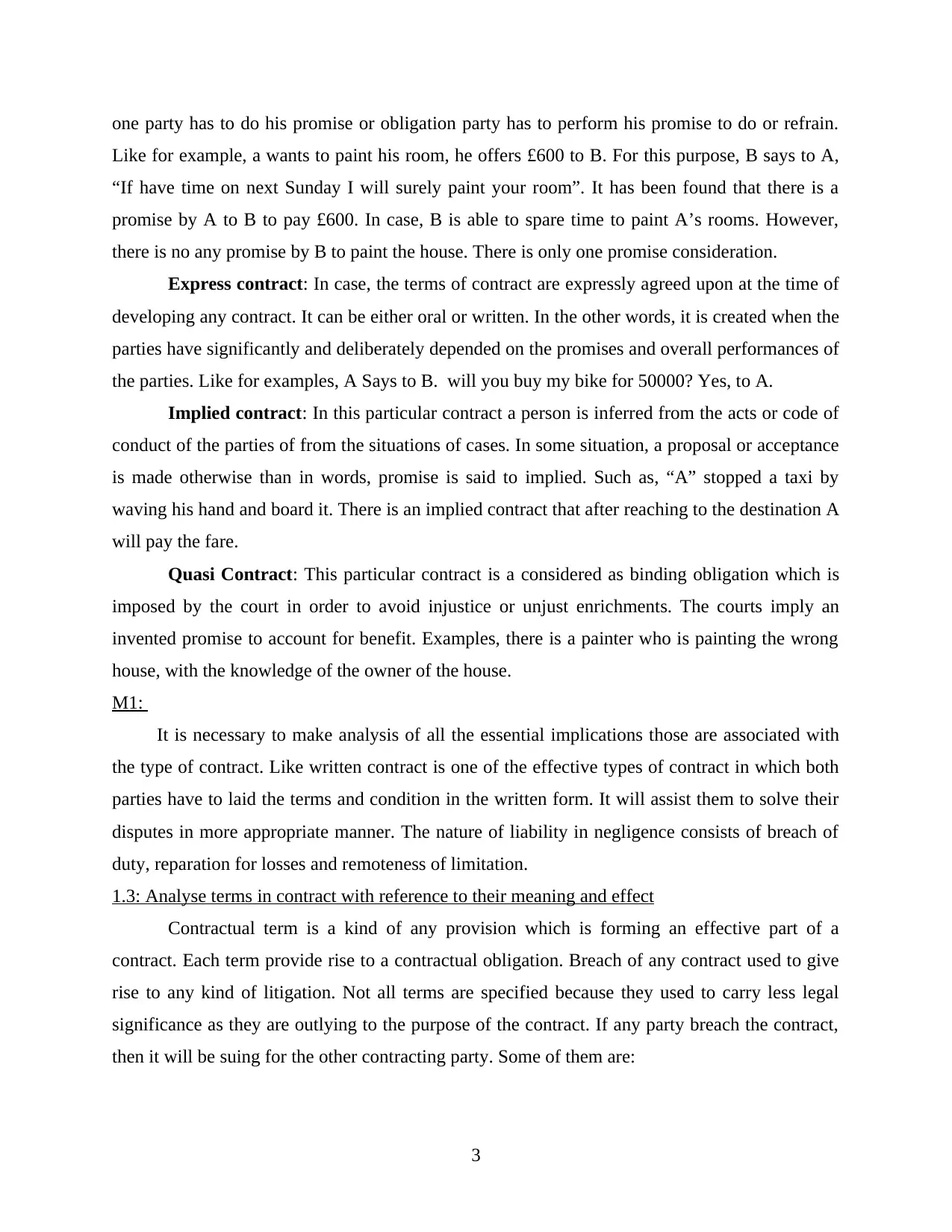
one party has to do his promise or obligation party has to perform his promise to do or refrain.
Like for example, a wants to paint his room, he offers £600 to B. For this purpose, B says to A,
“If have time on next Sunday I will surely paint your room”. It has been found that there is a
promise by A to B to pay £600. In case, B is able to spare time to paint A’s rooms. However,
there is no any promise by B to paint the house. There is only one promise consideration.
Express contract: In case, the terms of contract are expressly agreed upon at the time of
developing any contract. It can be either oral or written. In the other words, it is created when the
parties have significantly and deliberately depended on the promises and overall performances of
the parties. Like for examples, A Says to B. will you buy my bike for 50000? Yes, to A.
Implied contract: In this particular contract a person is inferred from the acts or code of
conduct of the parties of from the situations of cases. In some situation, a proposal or acceptance
is made otherwise than in words, promise is said to implied. Such as, “A” stopped a taxi by
waving his hand and board it. There is an implied contract that after reaching to the destination A
will pay the fare.
Quasi Contract: This particular contract is a considered as binding obligation which is
imposed by the court in order to avoid injustice or unjust enrichments. The courts imply an
invented promise to account for benefit. Examples, there is a painter who is painting the wrong
house, with the knowledge of the owner of the house.
M1:
It is necessary to make analysis of all the essential implications those are associated with
the type of contract. Like written contract is one of the effective types of contract in which both
parties have to laid the terms and condition in the written form. It will assist them to solve their
disputes in more appropriate manner. The nature of liability in negligence consists of breach of
duty, reparation for losses and remoteness of limitation.
1.3: Analyse terms in contract with reference to their meaning and effect
Contractual term is a kind of any provision which is forming an effective part of a
contract. Each term provide rise to a contractual obligation. Breach of any contract used to give
rise to any kind of litigation. Not all terms are specified because they used to carry less legal
significance as they are outlying to the purpose of the contract. If any party breach the contract,
then it will be suing for the other contracting party. Some of them are:
3
Like for example, a wants to paint his room, he offers £600 to B. For this purpose, B says to A,
“If have time on next Sunday I will surely paint your room”. It has been found that there is a
promise by A to B to pay £600. In case, B is able to spare time to paint A’s rooms. However,
there is no any promise by B to paint the house. There is only one promise consideration.
Express contract: In case, the terms of contract are expressly agreed upon at the time of
developing any contract. It can be either oral or written. In the other words, it is created when the
parties have significantly and deliberately depended on the promises and overall performances of
the parties. Like for examples, A Says to B. will you buy my bike for 50000? Yes, to A.
Implied contract: In this particular contract a person is inferred from the acts or code of
conduct of the parties of from the situations of cases. In some situation, a proposal or acceptance
is made otherwise than in words, promise is said to implied. Such as, “A” stopped a taxi by
waving his hand and board it. There is an implied contract that after reaching to the destination A
will pay the fare.
Quasi Contract: This particular contract is a considered as binding obligation which is
imposed by the court in order to avoid injustice or unjust enrichments. The courts imply an
invented promise to account for benefit. Examples, there is a painter who is painting the wrong
house, with the knowledge of the owner of the house.
M1:
It is necessary to make analysis of all the essential implications those are associated with
the type of contract. Like written contract is one of the effective types of contract in which both
parties have to laid the terms and condition in the written form. It will assist them to solve their
disputes in more appropriate manner. The nature of liability in negligence consists of breach of
duty, reparation for losses and remoteness of limitation.
1.3: Analyse terms in contract with reference to their meaning and effect
Contractual term is a kind of any provision which is forming an effective part of a
contract. Each term provide rise to a contractual obligation. Breach of any contract used to give
rise to any kind of litigation. Not all terms are specified because they used to carry less legal
significance as they are outlying to the purpose of the contract. If any party breach the contract,
then it will be suing for the other contracting party. Some of them are:
3
⊘ This is a preview!⊘
Do you want full access?
Subscribe today to unlock all pages.

Trusted by 1+ million students worldwide
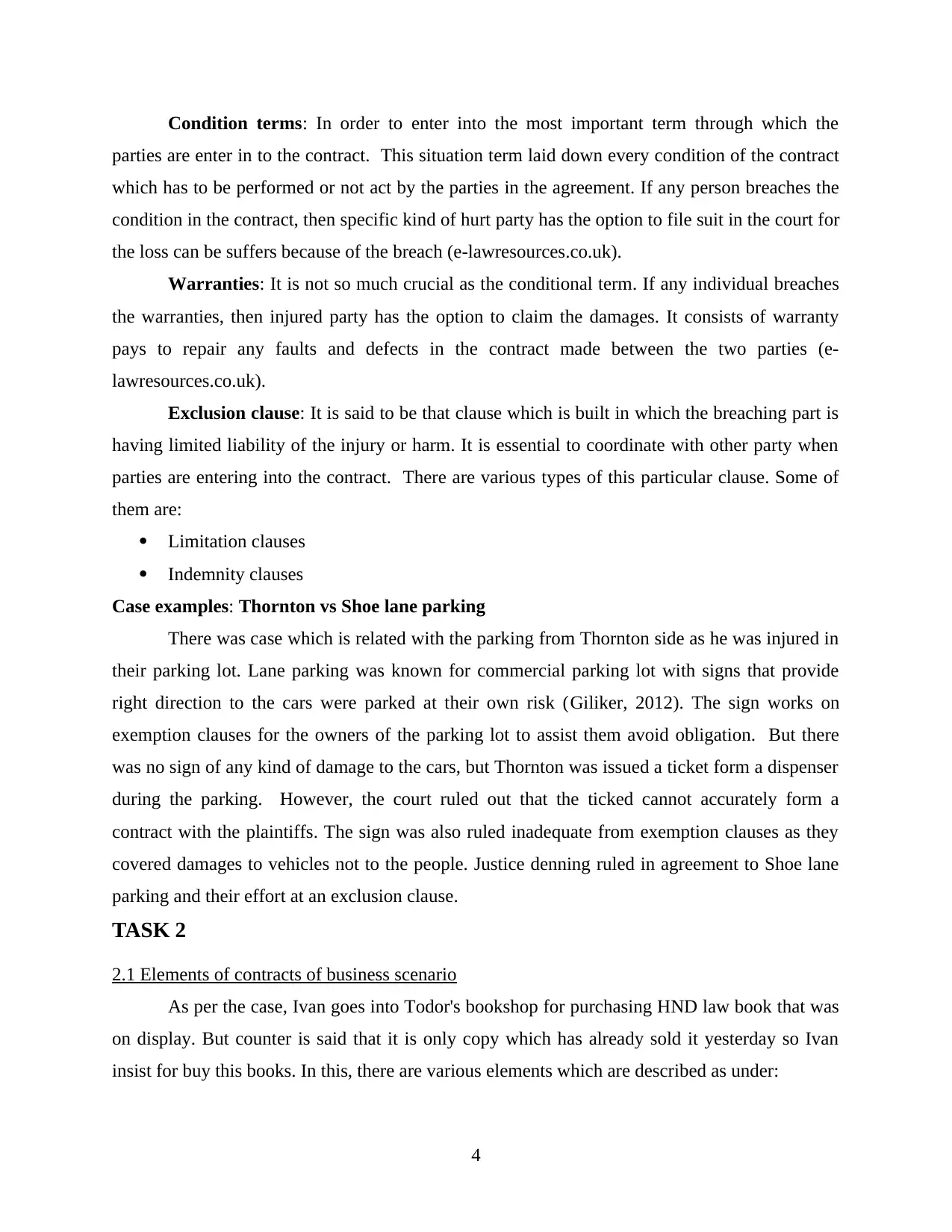
Condition terms: In order to enter into the most important term through which the
parties are enter in to the contract. This situation term laid down every condition of the contract
which has to be performed or not act by the parties in the agreement. If any person breaches the
condition in the contract, then specific kind of hurt party has the option to file suit in the court for
the loss can be suffers because of the breach (e-lawresources.co.uk).
Warranties: It is not so much crucial as the conditional term. If any individual breaches
the warranties, then injured party has the option to claim the damages. It consists of warranty
pays to repair any faults and defects in the contract made between the two parties (e-
lawresources.co.uk).
Exclusion clause: It is said to be that clause which is built in which the breaching part is
having limited liability of the injury or harm. It is essential to coordinate with other party when
parties are entering into the contract. There are various types of this particular clause. Some of
them are:
Limitation clauses
Indemnity clauses
Case examples: Thornton vs Shoe lane parking
There was case which is related with the parking from Thornton side as he was injured in
their parking lot. Lane parking was known for commercial parking lot with signs that provide
right direction to the cars were parked at their own risk (Giliker, 2012). The sign works on
exemption clauses for the owners of the parking lot to assist them avoid obligation. But there
was no sign of any kind of damage to the cars, but Thornton was issued a ticket form a dispenser
during the parking. However, the court ruled out that the ticked cannot accurately form a
contract with the plaintiffs. The sign was also ruled inadequate from exemption clauses as they
covered damages to vehicles not to the people. Justice denning ruled in agreement to Shoe lane
parking and their effort at an exclusion clause.
TASK 2
2.1 Elements of contracts of business scenario
As per the case, Ivan goes into Todor's bookshop for purchasing HND law book that was
on display. But counter is said that it is only copy which has already sold it yesterday so Ivan
insist for buy this books. In this, there are various elements which are described as under:
4
parties are enter in to the contract. This situation term laid down every condition of the contract
which has to be performed or not act by the parties in the agreement. If any person breaches the
condition in the contract, then specific kind of hurt party has the option to file suit in the court for
the loss can be suffers because of the breach (e-lawresources.co.uk).
Warranties: It is not so much crucial as the conditional term. If any individual breaches
the warranties, then injured party has the option to claim the damages. It consists of warranty
pays to repair any faults and defects in the contract made between the two parties (e-
lawresources.co.uk).
Exclusion clause: It is said to be that clause which is built in which the breaching part is
having limited liability of the injury or harm. It is essential to coordinate with other party when
parties are entering into the contract. There are various types of this particular clause. Some of
them are:
Limitation clauses
Indemnity clauses
Case examples: Thornton vs Shoe lane parking
There was case which is related with the parking from Thornton side as he was injured in
their parking lot. Lane parking was known for commercial parking lot with signs that provide
right direction to the cars were parked at their own risk (Giliker, 2012). The sign works on
exemption clauses for the owners of the parking lot to assist them avoid obligation. But there
was no sign of any kind of damage to the cars, but Thornton was issued a ticket form a dispenser
during the parking. However, the court ruled out that the ticked cannot accurately form a
contract with the plaintiffs. The sign was also ruled inadequate from exemption clauses as they
covered damages to vehicles not to the people. Justice denning ruled in agreement to Shoe lane
parking and their effort at an exclusion clause.
TASK 2
2.1 Elements of contracts of business scenario
As per the case, Ivan goes into Todor's bookshop for purchasing HND law book that was
on display. But counter is said that it is only copy which has already sold it yesterday so Ivan
insist for buy this books. In this, there are various elements which are described as under:
4
Paraphrase This Document
Need a fresh take? Get an instant paraphrase of this document with our AI Paraphraser
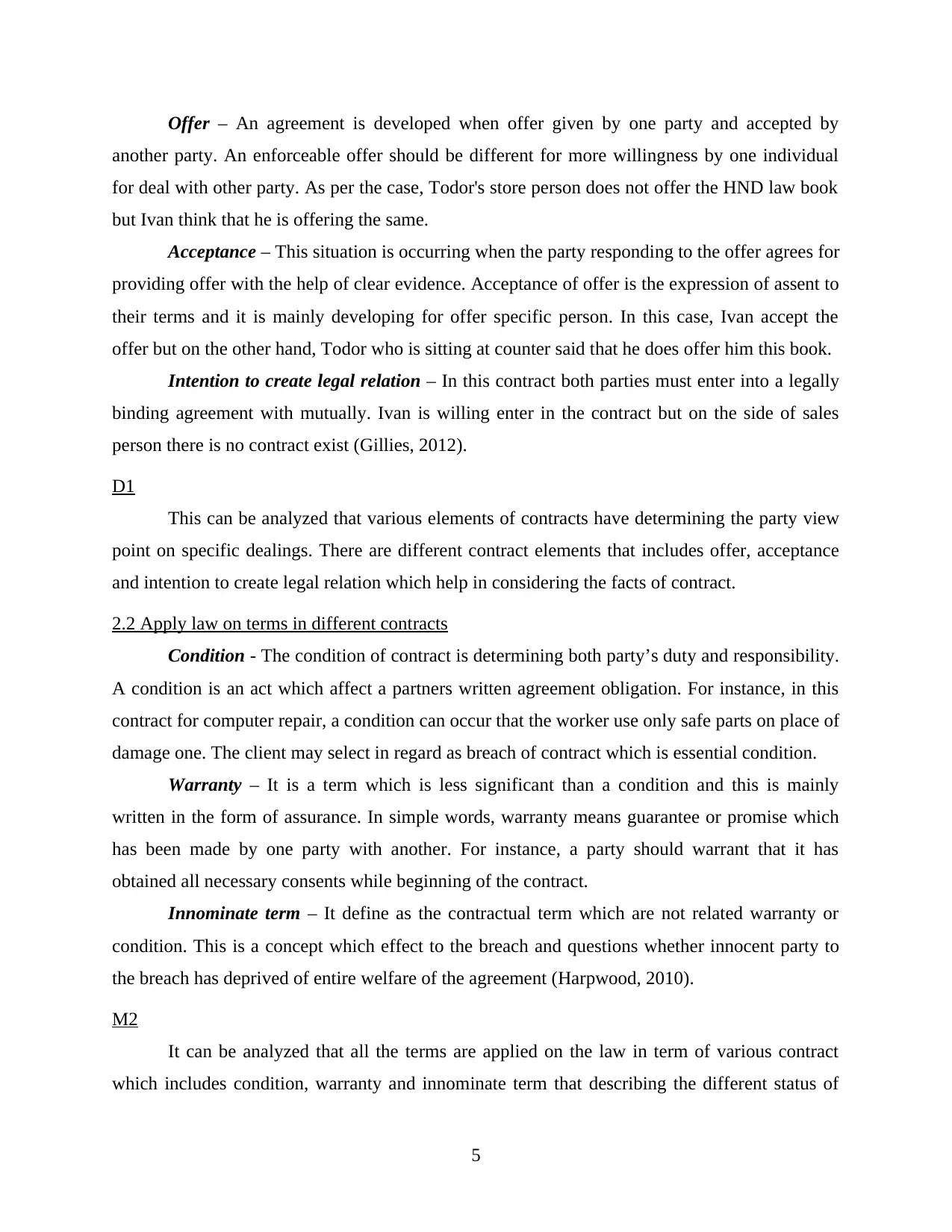
Offer – An agreement is developed when offer given by one party and accepted by
another party. An enforceable offer should be different for more willingness by one individual
for deal with other party. As per the case, Todor's store person does not offer the HND law book
but Ivan think that he is offering the same.
Acceptance – This situation is occurring when the party responding to the offer agrees for
providing offer with the help of clear evidence. Acceptance of offer is the expression of assent to
their terms and it is mainly developing for offer specific person. In this case, Ivan accept the
offer but on the other hand, Todor who is sitting at counter said that he does offer him this book.
Intention to create legal relation – In this contract both parties must enter into a legally
binding agreement with mutually. Ivan is willing enter in the contract but on the side of sales
person there is no contract exist (Gillies, 2012).
D1
This can be analyzed that various elements of contracts have determining the party view
point on specific dealings. There are different contract elements that includes offer, acceptance
and intention to create legal relation which help in considering the facts of contract.
2.2 Apply law on terms in different contracts
Condition - The condition of contract is determining both party’s duty and responsibility.
A condition is an act which affect a partners written agreement obligation. For instance, in this
contract for computer repair, a condition can occur that the worker use only safe parts on place of
damage one. The client may select in regard as breach of contract which is essential condition.
Warranty – It is a term which is less significant than a condition and this is mainly
written in the form of assurance. In simple words, warranty means guarantee or promise which
has been made by one party with another. For instance, a party should warrant that it has
obtained all necessary consents while beginning of the contract.
Innominate term – It define as the contractual term which are not related warranty or
condition. This is a concept which effect to the breach and questions whether innocent party to
the breach has deprived of entire welfare of the agreement (Harpwood, 2010).
M2
It can be analyzed that all the terms are applied on the law in term of various contract
which includes condition, warranty and innominate term that describing the different status of
5
another party. An enforceable offer should be different for more willingness by one individual
for deal with other party. As per the case, Todor's store person does not offer the HND law book
but Ivan think that he is offering the same.
Acceptance – This situation is occurring when the party responding to the offer agrees for
providing offer with the help of clear evidence. Acceptance of offer is the expression of assent to
their terms and it is mainly developing for offer specific person. In this case, Ivan accept the
offer but on the other hand, Todor who is sitting at counter said that he does offer him this book.
Intention to create legal relation – In this contract both parties must enter into a legally
binding agreement with mutually. Ivan is willing enter in the contract but on the side of sales
person there is no contract exist (Gillies, 2012).
D1
This can be analyzed that various elements of contracts have determining the party view
point on specific dealings. There are different contract elements that includes offer, acceptance
and intention to create legal relation which help in considering the facts of contract.
2.2 Apply law on terms in different contracts
Condition - The condition of contract is determining both party’s duty and responsibility.
A condition is an act which affect a partners written agreement obligation. For instance, in this
contract for computer repair, a condition can occur that the worker use only safe parts on place of
damage one. The client may select in regard as breach of contract which is essential condition.
Warranty – It is a term which is less significant than a condition and this is mainly
written in the form of assurance. In simple words, warranty means guarantee or promise which
has been made by one party with another. For instance, a party should warrant that it has
obtained all necessary consents while beginning of the contract.
Innominate term – It define as the contractual term which are not related warranty or
condition. This is a concept which effect to the breach and questions whether innocent party to
the breach has deprived of entire welfare of the agreement (Harpwood, 2010).
M2
It can be analyzed that all the terms are applied on the law in term of various contract
which includes condition, warranty and innominate term that describing the different status of
5
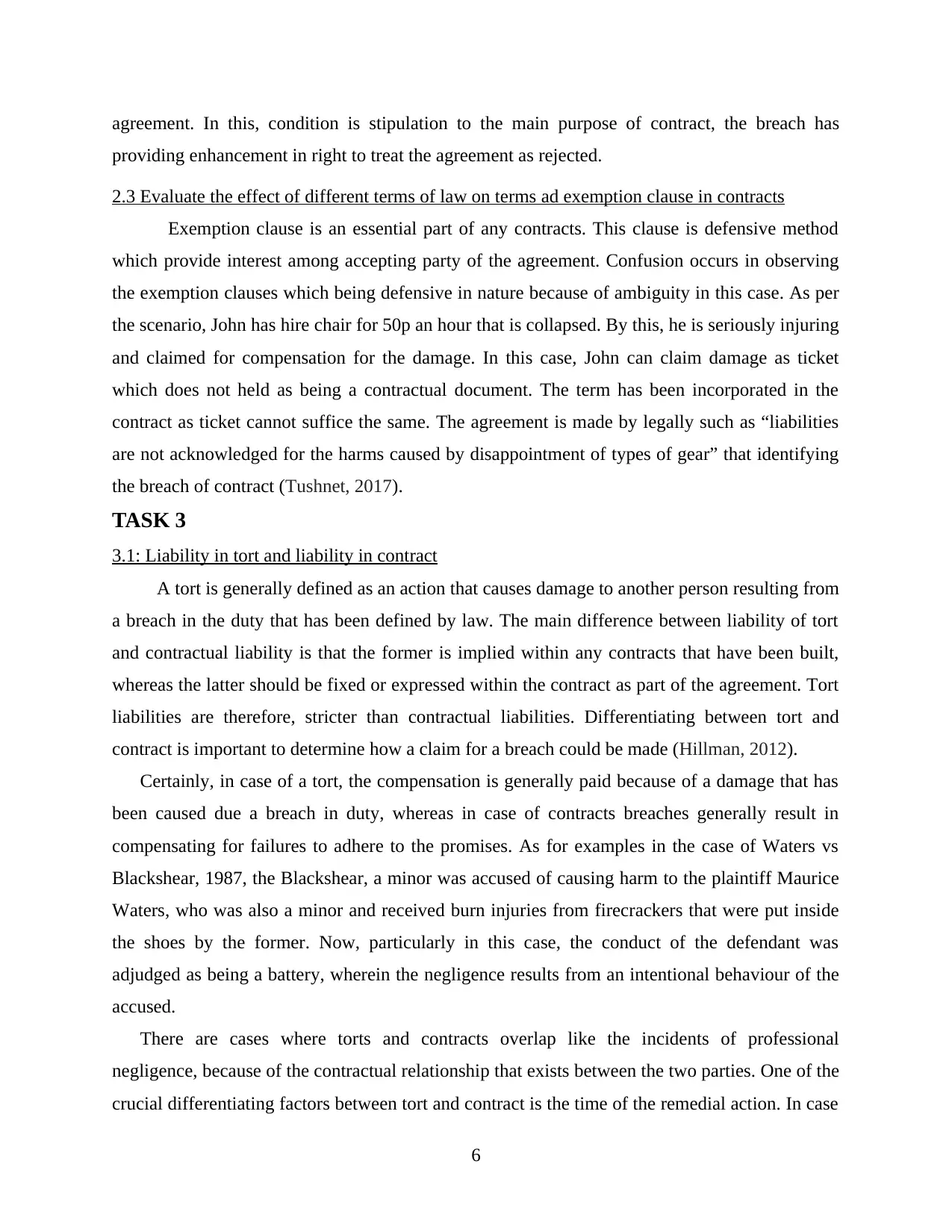
agreement. In this, condition is stipulation to the main purpose of contract, the breach has
providing enhancement in right to treat the agreement as rejected.
2.3 Evaluate the effect of different terms of law on terms ad exemption clause in contracts
Exemption clause is an essential part of any contracts. This clause is defensive method
which provide interest among accepting party of the agreement. Confusion occurs in observing
the exemption clauses which being defensive in nature because of ambiguity in this case. As per
the scenario, John has hire chair for 50p an hour that is collapsed. By this, he is seriously injuring
and claimed for compensation for the damage. In this case, John can claim damage as ticket
which does not held as being a contractual document. The term has been incorporated in the
contract as ticket cannot suffice the same. The agreement is made by legally such as “liabilities
are not acknowledged for the harms caused by disappointment of types of gear” that identifying
the breach of contract (Tushnet, 2017).
TASK 3
3.1: Liability in tort and liability in contract
A tort is generally defined as an action that causes damage to another person resulting from
a breach in the duty that has been defined by law. The main difference between liability of tort
and contractual liability is that the former is implied within any contracts that have been built,
whereas the latter should be fixed or expressed within the contract as part of the agreement. Tort
liabilities are therefore, stricter than contractual liabilities. Differentiating between tort and
contract is important to determine how a claim for a breach could be made (Hillman, 2012).
Certainly, in case of a tort, the compensation is generally paid because of a damage that has
been caused due a breach in duty, whereas in case of contracts breaches generally result in
compensating for failures to adhere to the promises. As for examples in the case of Waters vs
Blackshear, 1987, the Blackshear, a minor was accused of causing harm to the plaintiff Maurice
Waters, who was also a minor and received burn injuries from firecrackers that were put inside
the shoes by the former. Now, particularly in this case, the conduct of the defendant was
adjudged as being a battery, wherein the negligence results from an intentional behaviour of the
accused.
There are cases where torts and contracts overlap like the incidents of professional
negligence, because of the contractual relationship that exists between the two parties. One of the
crucial differentiating factors between tort and contract is the time of the remedial action. In case
6
providing enhancement in right to treat the agreement as rejected.
2.3 Evaluate the effect of different terms of law on terms ad exemption clause in contracts
Exemption clause is an essential part of any contracts. This clause is defensive method
which provide interest among accepting party of the agreement. Confusion occurs in observing
the exemption clauses which being defensive in nature because of ambiguity in this case. As per
the scenario, John has hire chair for 50p an hour that is collapsed. By this, he is seriously injuring
and claimed for compensation for the damage. In this case, John can claim damage as ticket
which does not held as being a contractual document. The term has been incorporated in the
contract as ticket cannot suffice the same. The agreement is made by legally such as “liabilities
are not acknowledged for the harms caused by disappointment of types of gear” that identifying
the breach of contract (Tushnet, 2017).
TASK 3
3.1: Liability in tort and liability in contract
A tort is generally defined as an action that causes damage to another person resulting from
a breach in the duty that has been defined by law. The main difference between liability of tort
and contractual liability is that the former is implied within any contracts that have been built,
whereas the latter should be fixed or expressed within the contract as part of the agreement. Tort
liabilities are therefore, stricter than contractual liabilities. Differentiating between tort and
contract is important to determine how a claim for a breach could be made (Hillman, 2012).
Certainly, in case of a tort, the compensation is generally paid because of a damage that has
been caused due a breach in duty, whereas in case of contracts breaches generally result in
compensating for failures to adhere to the promises. As for examples in the case of Waters vs
Blackshear, 1987, the Blackshear, a minor was accused of causing harm to the plaintiff Maurice
Waters, who was also a minor and received burn injuries from firecrackers that were put inside
the shoes by the former. Now, particularly in this case, the conduct of the defendant was
adjudged as being a battery, wherein the negligence results from an intentional behaviour of the
accused.
There are cases where torts and contracts overlap like the incidents of professional
negligence, because of the contractual relationship that exists between the two parties. One of the
crucial differentiating factors between tort and contract is the time of the remedial action. In case
6
⊘ This is a preview!⊘
Do you want full access?
Subscribe today to unlock all pages.

Trusted by 1+ million students worldwide
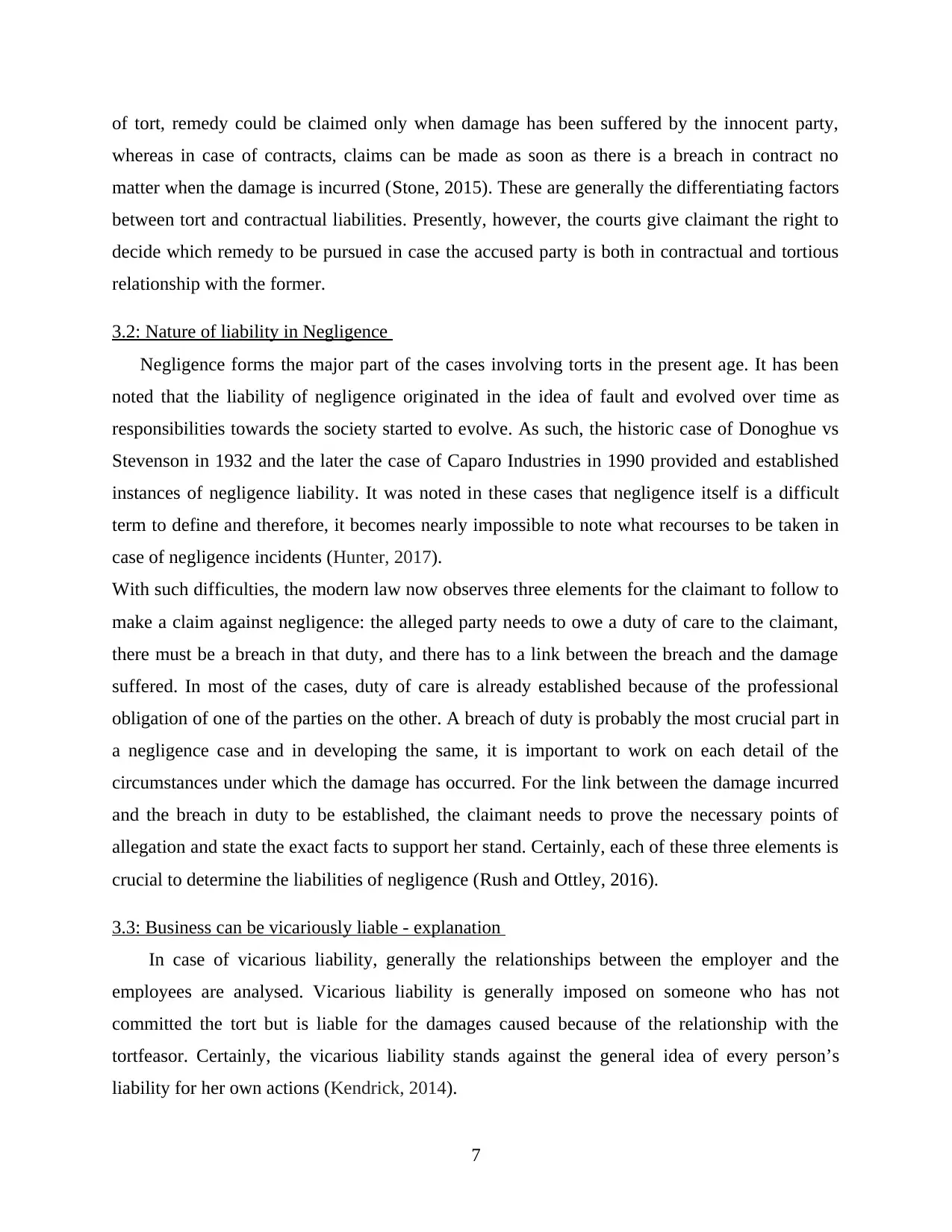
of tort, remedy could be claimed only when damage has been suffered by the innocent party,
whereas in case of contracts, claims can be made as soon as there is a breach in contract no
matter when the damage is incurred (Stone, 2015). These are generally the differentiating factors
between tort and contractual liabilities. Presently, however, the courts give claimant the right to
decide which remedy to be pursued in case the accused party is both in contractual and tortious
relationship with the former.
3.2: Nature of liability in Negligence
Negligence forms the major part of the cases involving torts in the present age. It has been
noted that the liability of negligence originated in the idea of fault and evolved over time as
responsibilities towards the society started to evolve. As such, the historic case of Donoghue vs
Stevenson in 1932 and the later the case of Caparo Industries in 1990 provided and established
instances of negligence liability. It was noted in these cases that negligence itself is a difficult
term to define and therefore, it becomes nearly impossible to note what recourses to be taken in
case of negligence incidents (Hunter, 2017).
With such difficulties, the modern law now observes three elements for the claimant to follow to
make a claim against negligence: the alleged party needs to owe a duty of care to the claimant,
there must be a breach in that duty, and there has to a link between the breach and the damage
suffered. In most of the cases, duty of care is already established because of the professional
obligation of one of the parties on the other. A breach of duty is probably the most crucial part in
a negligence case and in developing the same, it is important to work on each detail of the
circumstances under which the damage has occurred. For the link between the damage incurred
and the breach in duty to be established, the claimant needs to prove the necessary points of
allegation and state the exact facts to support her stand. Certainly, each of these three elements is
crucial to determine the liabilities of negligence (Rush and Ottley, 2016).
3.3: Business can be vicariously liable - explanation
In case of vicarious liability, generally the relationships between the employer and the
employees are analysed. Vicarious liability is generally imposed on someone who has not
committed the tort but is liable for the damages caused because of the relationship with the
tortfeasor. Certainly, the vicarious liability stands against the general idea of every person’s
liability for her own actions (Kendrick, 2014).
7
whereas in case of contracts, claims can be made as soon as there is a breach in contract no
matter when the damage is incurred (Stone, 2015). These are generally the differentiating factors
between tort and contractual liabilities. Presently, however, the courts give claimant the right to
decide which remedy to be pursued in case the accused party is both in contractual and tortious
relationship with the former.
3.2: Nature of liability in Negligence
Negligence forms the major part of the cases involving torts in the present age. It has been
noted that the liability of negligence originated in the idea of fault and evolved over time as
responsibilities towards the society started to evolve. As such, the historic case of Donoghue vs
Stevenson in 1932 and the later the case of Caparo Industries in 1990 provided and established
instances of negligence liability. It was noted in these cases that negligence itself is a difficult
term to define and therefore, it becomes nearly impossible to note what recourses to be taken in
case of negligence incidents (Hunter, 2017).
With such difficulties, the modern law now observes three elements for the claimant to follow to
make a claim against negligence: the alleged party needs to owe a duty of care to the claimant,
there must be a breach in that duty, and there has to a link between the breach and the damage
suffered. In most of the cases, duty of care is already established because of the professional
obligation of one of the parties on the other. A breach of duty is probably the most crucial part in
a negligence case and in developing the same, it is important to work on each detail of the
circumstances under which the damage has occurred. For the link between the damage incurred
and the breach in duty to be established, the claimant needs to prove the necessary points of
allegation and state the exact facts to support her stand. Certainly, each of these three elements is
crucial to determine the liabilities of negligence (Rush and Ottley, 2016).
3.3: Business can be vicariously liable - explanation
In case of vicarious liability, generally the relationships between the employer and the
employees are analysed. Vicarious liability is generally imposed on someone who has not
committed the tort but is liable for the damages caused because of the relationship with the
tortfeasor. Certainly, the vicarious liability stands against the general idea of every person’s
liability for her own actions (Kendrick, 2014).
7
Paraphrase This Document
Need a fresh take? Get an instant paraphrase of this document with our AI Paraphraser
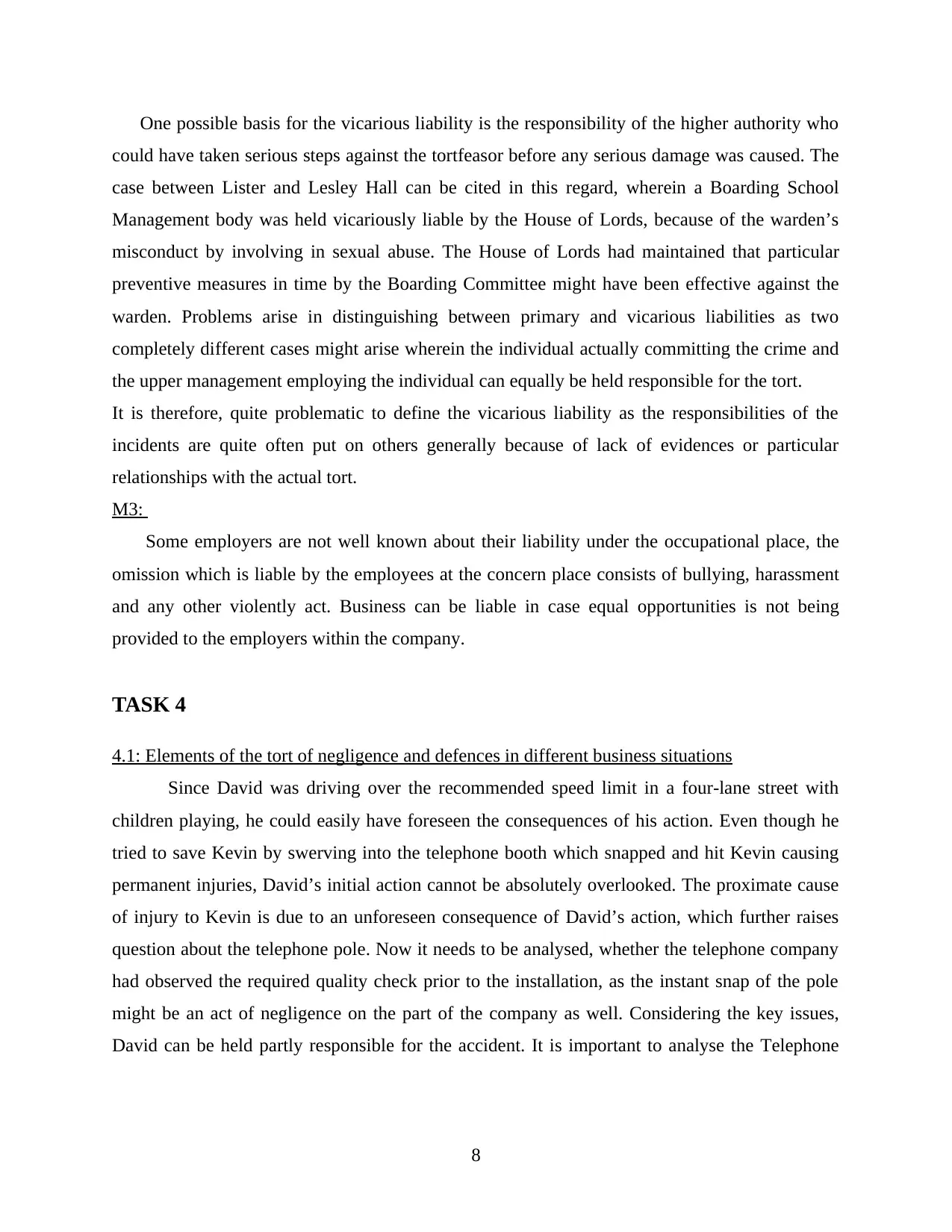
One possible basis for the vicarious liability is the responsibility of the higher authority who
could have taken serious steps against the tortfeasor before any serious damage was caused. The
case between Lister and Lesley Hall can be cited in this regard, wherein a Boarding School
Management body was held vicariously liable by the House of Lords, because of the warden’s
misconduct by involving in sexual abuse. The House of Lords had maintained that particular
preventive measures in time by the Boarding Committee might have been effective against the
warden. Problems arise in distinguishing between primary and vicarious liabilities as two
completely different cases might arise wherein the individual actually committing the crime and
the upper management employing the individual can equally be held responsible for the tort.
It is therefore, quite problematic to define the vicarious liability as the responsibilities of the
incidents are quite often put on others generally because of lack of evidences or particular
relationships with the actual tort.
M3:
Some employers are not well known about their liability under the occupational place, the
omission which is liable by the employees at the concern place consists of bullying, harassment
and any other violently act. Business can be liable in case equal opportunities is not being
provided to the employers within the company.
TASK 4
4.1: Elements of the tort of negligence and defences in different business situations
Since David was driving over the recommended speed limit in a four-lane street with
children playing, he could easily have foreseen the consequences of his action. Even though he
tried to save Kevin by swerving into the telephone booth which snapped and hit Kevin causing
permanent injuries, David’s initial action cannot be absolutely overlooked. The proximate cause
of injury to Kevin is due to an unforeseen consequence of David’s action, which further raises
question about the telephone pole. Now it needs to be analysed, whether the telephone company
had observed the required quality check prior to the installation, as the instant snap of the pole
might be an act of negligence on the part of the company as well. Considering the key issues,
David can be held partly responsible for the accident. It is important to analyse the Telephone
8
could have taken serious steps against the tortfeasor before any serious damage was caused. The
case between Lister and Lesley Hall can be cited in this regard, wherein a Boarding School
Management body was held vicariously liable by the House of Lords, because of the warden’s
misconduct by involving in sexual abuse. The House of Lords had maintained that particular
preventive measures in time by the Boarding Committee might have been effective against the
warden. Problems arise in distinguishing between primary and vicarious liabilities as two
completely different cases might arise wherein the individual actually committing the crime and
the upper management employing the individual can equally be held responsible for the tort.
It is therefore, quite problematic to define the vicarious liability as the responsibilities of the
incidents are quite often put on others generally because of lack of evidences or particular
relationships with the actual tort.
M3:
Some employers are not well known about their liability under the occupational place, the
omission which is liable by the employees at the concern place consists of bullying, harassment
and any other violently act. Business can be liable in case equal opportunities is not being
provided to the employers within the company.
TASK 4
4.1: Elements of the tort of negligence and defences in different business situations
Since David was driving over the recommended speed limit in a four-lane street with
children playing, he could easily have foreseen the consequences of his action. Even though he
tried to save Kevin by swerving into the telephone booth which snapped and hit Kevin causing
permanent injuries, David’s initial action cannot be absolutely overlooked. The proximate cause
of injury to Kevin is due to an unforeseen consequence of David’s action, which further raises
question about the telephone pole. Now it needs to be analysed, whether the telephone company
had observed the required quality check prior to the installation, as the instant snap of the pole
might be an act of negligence on the part of the company as well. Considering the key issues,
David can be held partly responsible for the accident. It is important to analyse the Telephone
8
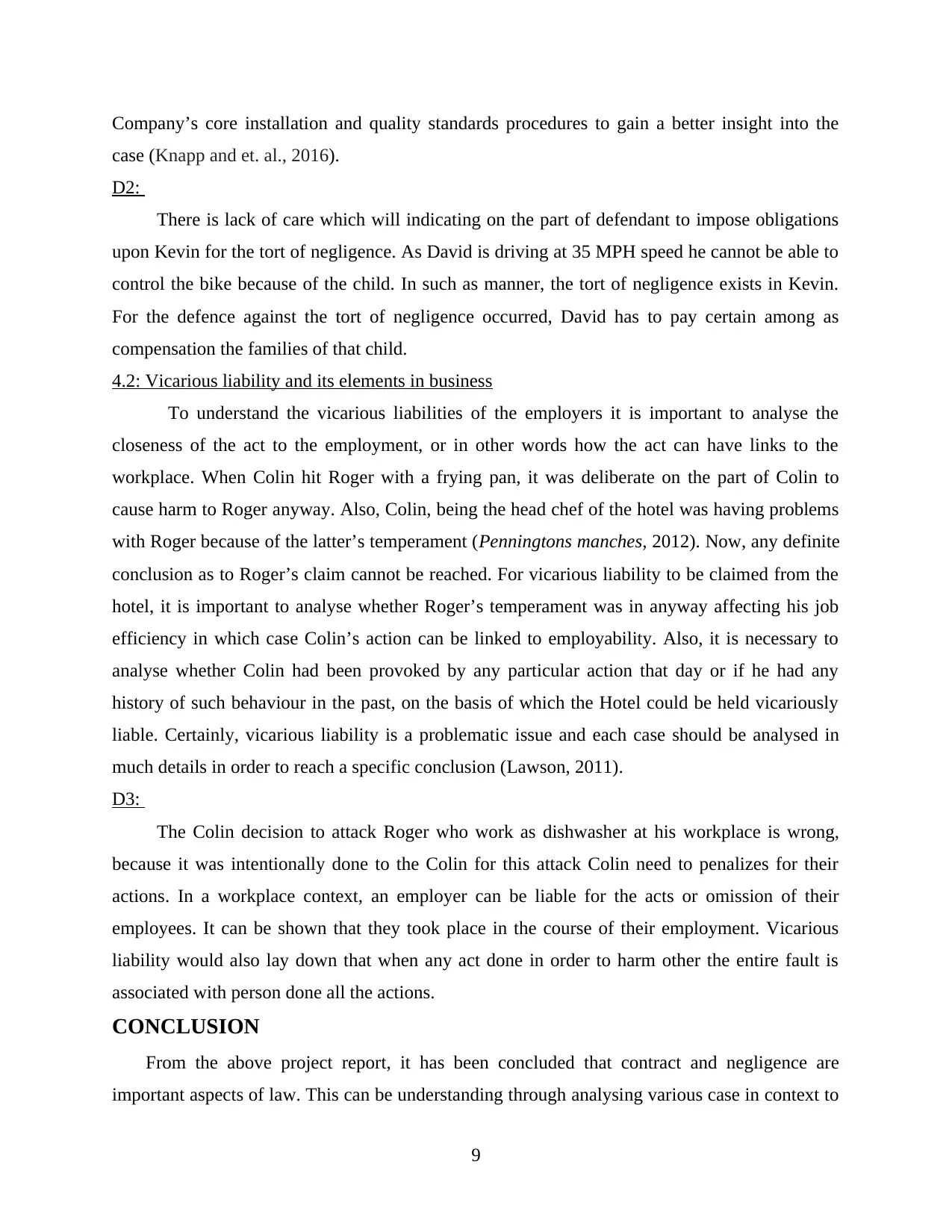
Company’s core installation and quality standards procedures to gain a better insight into the
case (Knapp and et. al., 2016).
D2:
There is lack of care which will indicating on the part of defendant to impose obligations
upon Kevin for the tort of negligence. As David is driving at 35 MPH speed he cannot be able to
control the bike because of the child. In such as manner, the tort of negligence exists in Kevin.
For the defence against the tort of negligence occurred, David has to pay certain among as
compensation the families of that child.
4.2: Vicarious liability and its elements in business
To understand the vicarious liabilities of the employers it is important to analyse the
closeness of the act to the employment, or in other words how the act can have links to the
workplace. When Colin hit Roger with a frying pan, it was deliberate on the part of Colin to
cause harm to Roger anyway. Also, Colin, being the head chef of the hotel was having problems
with Roger because of the latter’s temperament (Penningtons manches, 2012). Now, any definite
conclusion as to Roger’s claim cannot be reached. For vicarious liability to be claimed from the
hotel, it is important to analyse whether Roger’s temperament was in anyway affecting his job
efficiency in which case Colin’s action can be linked to employability. Also, it is necessary to
analyse whether Colin had been provoked by any particular action that day or if he had any
history of such behaviour in the past, on the basis of which the Hotel could be held vicariously
liable. Certainly, vicarious liability is a problematic issue and each case should be analysed in
much details in order to reach a specific conclusion (Lawson, 2011).
D3:
The Colin decision to attack Roger who work as dishwasher at his workplace is wrong,
because it was intentionally done to the Colin for this attack Colin need to penalizes for their
actions. In a workplace context, an employer can be liable for the acts or omission of their
employees. It can be shown that they took place in the course of their employment. Vicarious
liability would also lay down that when any act done in order to harm other the entire fault is
associated with person done all the actions.
CONCLUSION
From the above project report, it has been concluded that contract and negligence are
important aspects of law. This can be understanding through analysing various case in context to
9
case (Knapp and et. al., 2016).
D2:
There is lack of care which will indicating on the part of defendant to impose obligations
upon Kevin for the tort of negligence. As David is driving at 35 MPH speed he cannot be able to
control the bike because of the child. In such as manner, the tort of negligence exists in Kevin.
For the defence against the tort of negligence occurred, David has to pay certain among as
compensation the families of that child.
4.2: Vicarious liability and its elements in business
To understand the vicarious liabilities of the employers it is important to analyse the
closeness of the act to the employment, or in other words how the act can have links to the
workplace. When Colin hit Roger with a frying pan, it was deliberate on the part of Colin to
cause harm to Roger anyway. Also, Colin, being the head chef of the hotel was having problems
with Roger because of the latter’s temperament (Penningtons manches, 2012). Now, any definite
conclusion as to Roger’s claim cannot be reached. For vicarious liability to be claimed from the
hotel, it is important to analyse whether Roger’s temperament was in anyway affecting his job
efficiency in which case Colin’s action can be linked to employability. Also, it is necessary to
analyse whether Colin had been provoked by any particular action that day or if he had any
history of such behaviour in the past, on the basis of which the Hotel could be held vicariously
liable. Certainly, vicarious liability is a problematic issue and each case should be analysed in
much details in order to reach a specific conclusion (Lawson, 2011).
D3:
The Colin decision to attack Roger who work as dishwasher at his workplace is wrong,
because it was intentionally done to the Colin for this attack Colin need to penalizes for their
actions. In a workplace context, an employer can be liable for the acts or omission of their
employees. It can be shown that they took place in the course of their employment. Vicarious
liability would also lay down that when any act done in order to harm other the entire fault is
associated with person done all the actions.
CONCLUSION
From the above project report, it has been concluded that contract and negligence are
important aspects of law. This can be understanding through analysing various case in context to
9
⊘ This is a preview!⊘
Do you want full access?
Subscribe today to unlock all pages.

Trusted by 1+ million students worldwide
1 out of 14
Related Documents
Your All-in-One AI-Powered Toolkit for Academic Success.
+13062052269
info@desklib.com
Available 24*7 on WhatsApp / Email
![[object Object]](/_next/static/media/star-bottom.7253800d.svg)
Unlock your academic potential
Copyright © 2020–2025 A2Z Services. All Rights Reserved. Developed and managed by ZUCOL.





